
Weasner's 8" LX200-ACF Report #2
Last updated: 28 October 2008
28 October 2008
It's a Keeper!
I took my new 8" LX200-ACF to Oracle Observatory for two nights of testing and use. You can read the full report for 25-27 October 2008 there. That report covers all the activities; this report will cover just the LX200 tests and usage. The accessory reviews have also been updated; see the 8" LX200-ACF Table of Contents page.
On past trips to Oracle Observatory with the LXD75-8"SC (the one that was stolen in December 2007) and the 8" LX90-ACF, I have set up the telescope a fair distance from where I parked my car. I would hand carry each item to the setup location; but with the minimal weight of each item, this was not difficult. I would move the tripod to the setup location and then the OTA. However, the 8" LX200-ACF OTA and fork mount combination is significantly heavier than the 8"SC and the 8" LX90-ACF OTA/fork mount. So I was glad that on this trip that I could park close to where I set up:
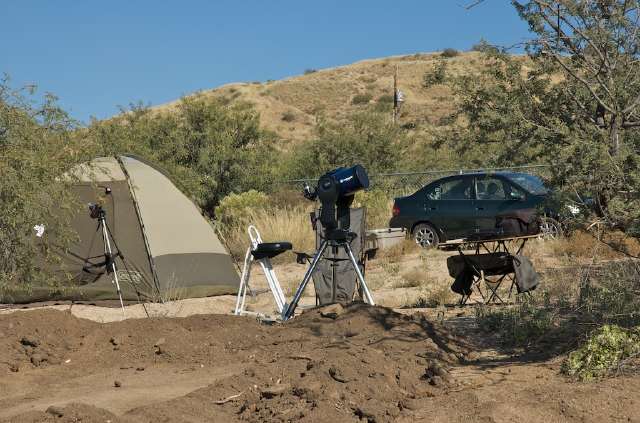
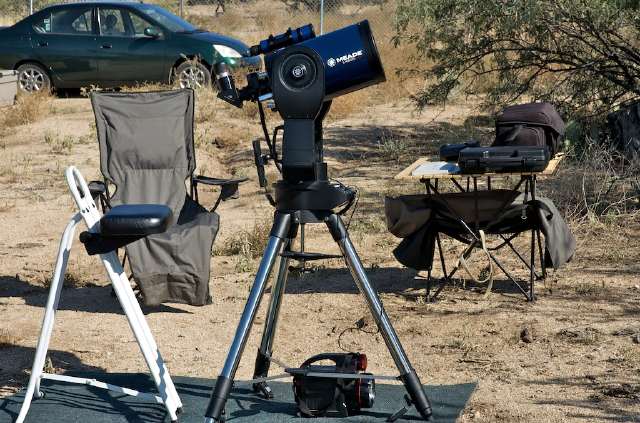
The first night was a visual night (astrophotography would be done on the second night). About 15 minutes after sunset on the first night, I manually pointed the telescope at Venus and then Jupiter, and viewed them using the supplied Series 5000 26mm eyepiece. Using the slow motion controls on the LX200 made manually centering objects really easy. I wish all telescopes had these slow motion controls. Venus was low in the sky, so it wasn't very stable, but I could still make out the phase. Jupiter was lovely, with some cloud bands and a hint of details. Three moons were easily seen as they were nicely grouped on one side of the planet's disk.
At 1835 MST, with the temperature at 55°F, I powered on the telescope and let the LX200 go through its alignment steps (finding north, level, GPS fix, alignment stars). I did a CALIBRATE SENSORS, as this was the first use at Oracle. At 1900 I did the "Great World Wide Star Count" test to determine the faintest star magnitude that could be seen from Oracle Observatory. I determined that Oracle Observatory has such dark skies that you can see down to magnitude 7 with the naked eye. This result has been reported (although it hasn't yet appeared on their web site).
After completing the Star Count test, I began some observing tests with the LX200-ACF. For the observing tests, I used the OPT 2" star diagonal. I used the supplied 1.25" 26mm eyepiece as well as the 1.25" 15mm eyepiece and 2" 30mm and 50mm eyepieces from the OPT kit. M13 and M57 were both spectacular in the 26mm and 15mm eyepieces. I could resolve some central stars in M13 in the 15mm. With the 30mm and 50mm eyepieces, the views were still nice, although the size of the objects was small. Stars were points of lights nearly to the edge of the field-of-view. The combination of the telescope Advanced Coma Free (ACF) optics and the quality of the OPT eyepieces made this possible. When viewing M57 in the 30mm eyepiece using averted vision, the ring almost appeared to glow. Lovely! M31 was a great view in the 50mm and 30mm eyepieces. You could see a lot of the galaxy's extent, with a hint of spiral arms being seen. In the 26mm and 15mm eyepieces, the central core was bright, with a hint of structure in the arms. Viewing the Double Cluster in the 30mm from this dark site on a moonless night was awesome. Both star clusters were almost entirely in the FOV. Some coma was just visible in brighter edge stars. The view through the 50mm eyepiece was nice, but the long eye-relief was almost too much for comfortable viewing of this large object. I then did the "Tonight's Best" guided tour and looked at open clusters, globular clusters, nebulae, galaxies, and Albireo. All were really nice in all the eyepieces. M27 was a nice sight in the 50mm eyepiece with the nebula sitting in a wide field of stars. But the best view of just the nebula was through the 15mm eyepiece. The galaxies M81 and M82 were low on the northern horizon; but they were still visible, showing some structure. Both galaxies were visible in the same FOV in the 30mm eyepiece. Nice!
Following the observing tests with the eyepieces, I did some tests of the Meade and Antares focal reducers. The results of those tests are discussed on the Accessory Reviews page.
After completing the focal reducer testing, I looked at M1. It had just risen over a small hill in the east. It was a distinctly shaped object in the 26mm and 30mm eyepieces. With the 15mm eyepiece, M1 had very little contrast from the background sky, due possibly to the low altitude.
I then decided to take a break. I put the AutoStar II to sleep. An hour and 15 minutes later (temperature down to 49°F), I woke the AutoStar and did a GOTO to M1. It was placed just outside the 15mm eyepiece FOV. That surprised me, as all the GOTOs I had done before putting it to sleep were placed near the center of the 15mm FOV. I checked the local time in the AutoStar and it was correct. I then did a GOTO to M42, and it was nearly centered in the 26mm FOV. M42 showed a lot of detail in the nebulosity. The Trapezium was well split. In the 30mm eyepiece, M42 was a beautiful sight, with lots of structure visible. In the 50mm it was OK but definitely not as nice as in the 30mm. I then added the Antares focal reducer and viewed M42 through the 30mm and 26mm eyepieces. Both showed really nice views, but it was better in the 30mm.
I then closed up for the night. But based on my first tests from a really dark sky site, the telescope is definitely a "keeper"!
The second night at Oracle Observatory was mainly an astrophotography night. I powered on the LX200-ACF about 5 minutes after sunset. I accepted the alignment stars as centered, since they were not yet visible in the still bright sky. I looked at Venus and Jupiter. Here's a single-frame photograph of Jupiter taken with my Nikon D70 DSLR at prime focus (with a 2X Barlow Lens). It was about a 1 second exposure (using the "hat trick" technique to avoid image vibration from the camera) at ISO 200.
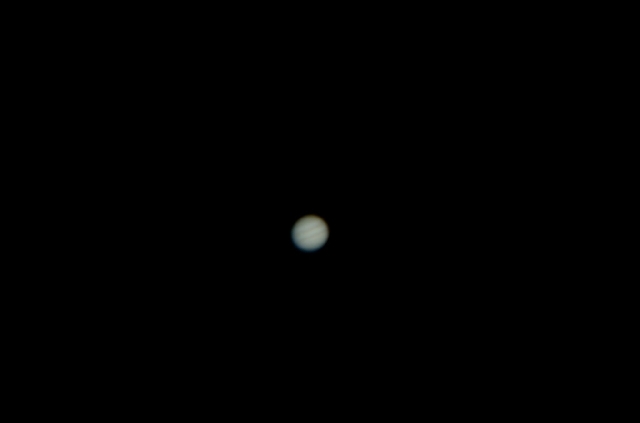
You can see a couple of cloud bands on the planet. I then decided to try capturing Jupiter with my iPhone (cell phone) camera. Here's the result:

This afocal photograph was taken by holding the iPhone camera lens over a 15mm eyepiece with 2X Barlow Lens (267X). A moon filter was attached to the eyepiece to reduce the brightness of Jupiter since the iPhone has no manual camera settings. Without the filter, Jupiter was overexposed. You can see the cloud bands, three of Jupiter's moons on the right, and if you look closely, you can see a star just left of Jupiter. By the way, this photo has received mention at the iPod Observer.
At 1840 MST I redid the alignment, since alignment stars were now visible. I did a GOTO M13, and it was placed right in the center of the 26mm eyepiece FOV. I then waited for it to get dark so that I could begin astrophotography tests with the Antares focal reducer (reported on the Meade and Antares Focal Reducers page). But here are some highlights of the night's astrophotography:
M57, Ring Nebula (cropped from the original full-frame, prime focus, 2 minute exposure, ISO 1600):
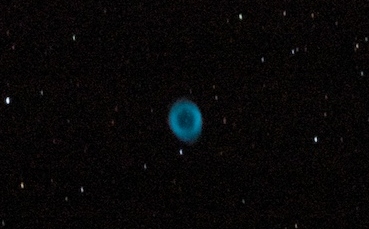
M13, Great Globular Cluster (cropped from the original full-frame, prime focus, 2 minute exposure, ISO 1600):
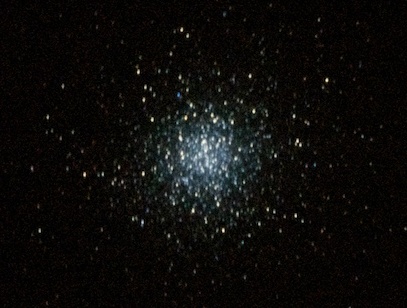
M27, Dumbbell Nebula (cropped from the original full-frame, prime focus, 2 minute exposure, ISO 1600), some image trailing:
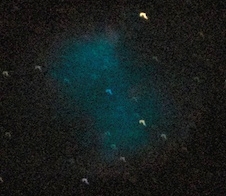
Double Cluster, two open star clusters (full-frame, prime focus, focal reducer, 1 minute exposure, ISO 1600):
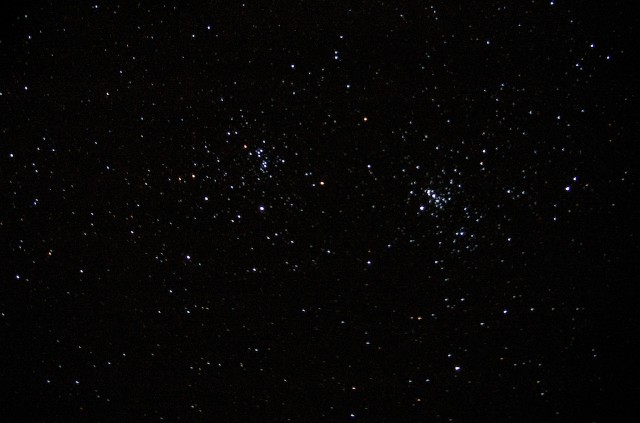
M31, Great Galaxy in Andromeda (full-frame, prime focus, focal reducer, 3 minute exposure, ISO 1600):
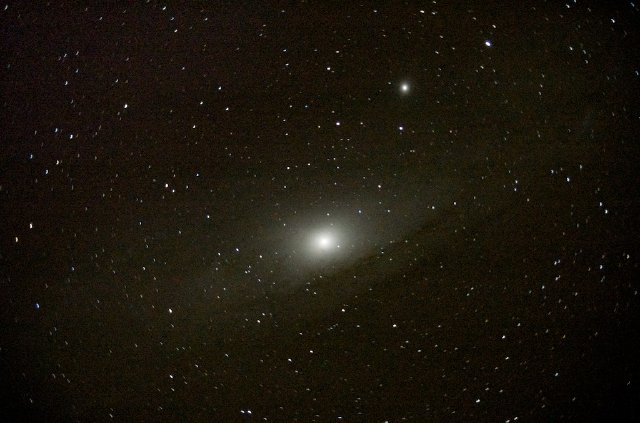
M45, Pleiades (full-frame, prime focus, focal reducer, 5 minute exposure, ISO 1600):
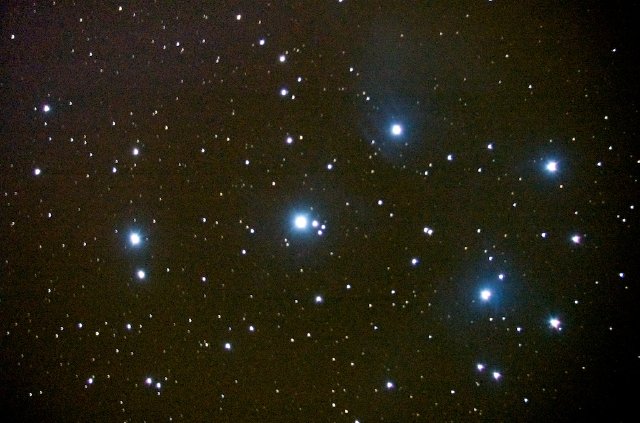
M1, Crab Nebula (full-frame, prime focus, focal reducer, 5 minute exposure, ISO 1600):
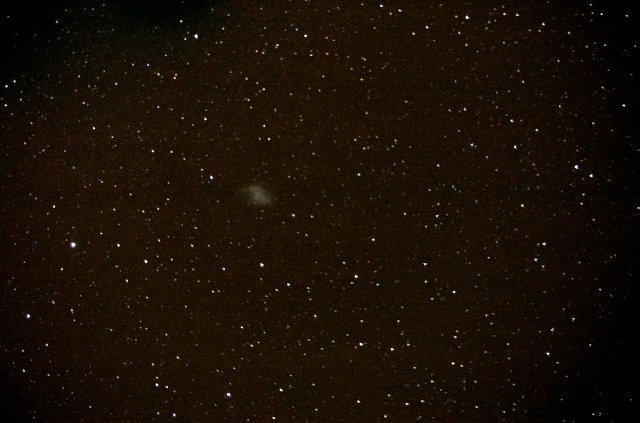
M42, Great Orion Nebula (full-frame, prime focus, focal reducer, 5 minute exposure, ISO 1600):
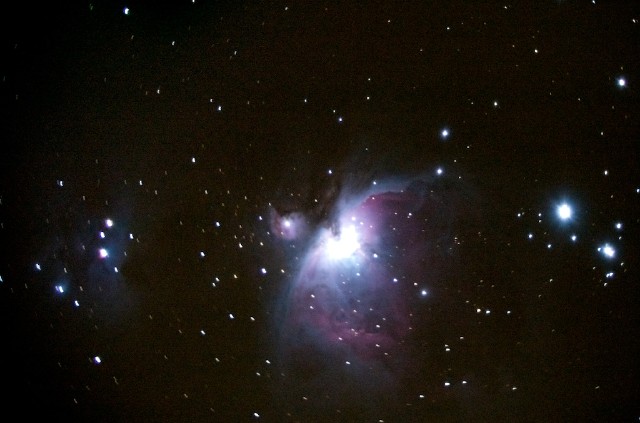
Noise Reduction was enabled in the D70 DSLR. The raw images were edited in Aperture.
About halfway through the night's astrophotography, I switched from using the Nikon D70 internal battery to an inverter with the D70 AC adapter powered by my Celestron Power Tank 12VDC 7AH. The Power Tank had powered the 8" LX200-ACF the previous night and was in use this night to power the telescope. About midnight on the second night, with the temperature up to 70°F, the "Needs Charging" LED illuminated on the Power Tank. That surprised me. The total usage since a full-charge the day before I left for Oracle Observatory was about 10 hours, including the last approximately 2 hours with the inverter attached. When I had my 8" LXD75, I was able to go easily for two full nights powering it and the AC inverter. The LX200 is obviously more power hungry! It will be great when AC electrical power is available at Oracle Observatory!
I decided to call it a night. This was a very successful two nights with the new telescope! Slewing and tracking were always smooth, and GOTOs with the AutoStar II were generally excellent. And the optics of the LX200-ACF are really outstanding. I'm very happy with my new 8" LX200-ACF. Definitely a KEEPER!!!
Go to back the 8" LX200-ACF Table of Contents.
Go to our Home Page.